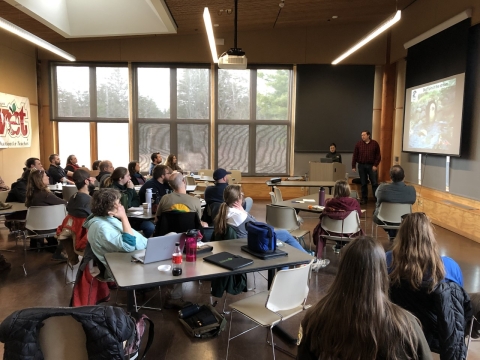States
Connecticut, Delaware, Maine, Maryland, Massachusetts, New Hampshire, New Jersey, New York, Pennsylvania, Rhode Island, Vermont, Virginia, West VirginiaEcosystem
River/streamAcross the landscape, undersized, aging and improperly placed road-stream crossings create barriers in our rivers, streams, and tidal wetlands. These structures fragment aquatic habitat and prevent or greatly reduce the ability of aquatic species to move freely to migrate, feed, and reproduce. These poorly designed structures are also more prone to clogging, causing flooding, and washing out in storms.
Stream Smart road crossings are designed to let the stream flow naturally beneath them. This keeps the stream habitat healthier and allows fish and other aquatic organisms to pass through. These crossings also tend to last longer, reduce maintenance costs, and improve public safety. The goal of Stream Smart road crossings is to connect fish and wildlife habitat while protecting roads to improve infrastructure resiliency and public safety.
The US Fish and Wildlife Service (Service), through programs such as the National Fish Passage Program, works with local communities to restore rivers and conserve our nation’s aquatic resources by removing or bypassing barriers. The Service has launched the Stream Smart training program so that communities and other partners can learn more about why and how to design and install Stream Smart crossings.
WHAT IS STREAM SMART?
Stream Smart is a training program and resource for anyone interested in planning, designing, or constructing road-stream crossings. The program was first launched in 2011 through Maine Audubon, in collaboration with the Service and other partners working in Maine. Numerous workshops and trainings have been offered since, leading to projects that have reconnected hundreds of miles of stream habitat in Maine for fish and wildlife. In collaboration with partner organizations, the Service has now developed Stream Smart trainings in other states across the northeast US.
WHO IS THIS TRAINING FOR?
The Service offers Stream Smart training to state and local resource and transportation agencies, conservation organizations, and other partners whose work may involve planning or constructing road-stream crossings, restoring connectivity to rivers for fish and other aquatic species, and improving resiliency of road-stream crossings to storms.
WHERE IS THE TRAINING OFFERED?
See the events page to find a training near you.
The Service offers the training in various locations across the northeast from Maine to West Virginia. We work with partner organizations to plan and implement the trainings, and we can work with you to develop and offer the Stream Smart training in a location near you.
If you are interested in helping to lead a Stream Smart training in your area, please reach out to the contacts below.
WHAT WILL I LEARN?
Stream Smart is a one-day course for agency staff, local municipalities, consultants, interested citizens, and other partners.
Through presentations and stream model demonstrations, participants will learn about the fundamental principles of Stream Simulation Design (the ecosystem-based approach developed by the USDA Forest Service for designing and constructing road-stream crossings), including the advantages of better stream crossings to improve aquatic habitat connectivity and resilience of roads to storm flows. The course will provide presentations and discussions on the following:
- Introductory concepts in the value of stream smart road crossings, including economic, habitat, and ecological values, as well as problems posed by crossings as barriers to aquatic connectivity.
- Regulatory guidelines for the state where the workshop is held.
- Technical guidance on how to create stream smart crossings, including information on assessment techniques and design principles.
- Cost and benefits of stream smart crossings, including long term cost savings and benefits relative to increased risk of more frequent and intense storm flows.
- Use of stream table models to demonstrate stream processes, problems of stream crossing barriers, and advantages of stream smart crossings.
WHERE CAN I GET MORE INFORMATION?
Contacts:
Cathy Bozek (catherine_bozek@fws.gov)





